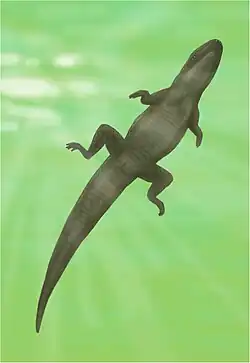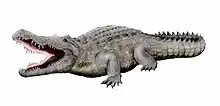Allognathosuchus
Allognathosuchus (meaning "other jaw crocodile") is an extinct genus of alligatorine crocodylian with a complicated taxonomic history. It was named in 1921.[2]
| Allognathosuchus Temporal range: Eocene, | |
|---|---|
 | |
| Scientific classification | |
| Domain: | Eukaryota |
| Kingdom: | Animalia |
| Phylum: | Chordata |
| Class: | Reptilia |
| Order: | Crocodilia |
| Family: | Alligatoridae |
| Subfamily: | Alligatorinae |
| Genus: | †Allognathosuchus Mook, 1921 |
| Species | |
| |
Description
Allognathosuchus was a medium-sized predator up to 1.5 m in length.[3] This alligatorine is known for its stout jaws and bulbous teeth, found near the rear of the tooth row in upper and lower jaws. These adaptations have historically been interpreted as having been for crushing mollusks. Isolated bulbous teeth are often assigned to this genus, although such teeth are known from other crocodyliform lineages.
Taxonomy
The type species, A. polyodon, is from the Eocene-age Bridger Formation of Wyoming; it is based on fossils that are difficult to distinguish from other Paleogene alligatorids. A. heterodon is from the Eocene-age Wasatch Formation of Wyoming, A. wartheni is from the Eocene-age Wildwood Formation (also known as the "Wildwood alligatorid" and possibly two species), and A. woutersi, which may belong to Diplocynodon, instead, is from the Early Eocene of Belgium. A. polyodon, A. heterodon, and A. wartheni span the Clarkforkian, Wasatchian, and Bridgerian North American Land Mammal Ages.[4]
Several other genera and species were previously assigned to Allognathosuchus, giving it a potential Upper Cretaceous-Oligocene stratigraphic range, and a geographic range covering North America, Europe, and Africa. Christopher Brochu reviewed the genus in 2004, and in light of the fragmentary remains of several of the species involved, recommended conservative use of the genus. He excluded Albertochampsa langstoni, Arambourgia gaudryi, and Wannaganosuchus brachymanus from Allognathosuchus, and resurrected Hassiacosuchus and Navajosuchus from synonymy with Allognathosuchus after finding them not to group with A. polyodon to the exclusion of other alligatorines.[4]
Recent studies have consistently resolved Allognathosuchus polyodon and Allognathosuchus wartheni as members of Alligatorinae, although their relative placement is disputed, as shown by the cladograms below.[5][6][7]
Cladogram from 2018 Bona et al. study:[5]
| Alligatorinae |
| ||||||||||||||||||||||||||||||||||||||||||||||||||||||||||||||||||||||||
Cladogram from 2019 Massonne et al. study:[6]
| Alligatorinae |
| |||||||||||||||||||||||||||||||||||||||||||||||||||||||||||||||||||||||||||
Cladogram from 2020 Cossette & Brochu study:[7]
| Alligatorinae |
| ||||||||||||||||||||||||||||||||||||||||||||||||||||||||||||||||||||||||
References
- Rio, Jonathan P.; Mannion, Philip D. (6 September 2021). "Phylogenetic analysis of a new morphological dataset elucidates the evolutionary history of Crocodylia and resolves the long-standing gharial problem". PeerJ. 9: e12094. doi:10.7717/peerj.12094. PMC 8428266. PMID 34567843.
- C. C. Mook. 1921. Allognathosuchus, a new genus of Eocene crocodilians. Bulletin of the American Museum of Natural History 44:105-110
- "Allognathosuchus : Eocene Mammals". Archived from the original on 2012-07-09. Retrieved 2012-05-23.
- Brochu, Christopher A. (2004). "Alligatorine phylogeny and the status of Allognathosuchus Mook, 1921". Journal of Vertebrate Paleontology. 24 (4): 857–873. doi:10.1671/0272-4634(2004)024[0857:APATSO]2.0.CO;2. JSTOR 4524781. S2CID 85050852.
- Paula Bona; Martín D. Ezcurra; Francisco Barrios; María V. Fernandez Blanco (2018). "A new Palaeocene crocodylian from southern Argentina sheds light on the early history of caimanines". Proceedings of the Royal Society B: Biological Sciences. 285 (1885): 20180843. doi:10.1098/rspb.2018.0843. PMC 6125902. PMID 30135152.
- Tobias Massonne; Davit Vasilyan; Márton Rabi; Madelaine Böhme (2019). "A new alligatoroid from the Eocene of Vietnam highlights an extinct Asian clade independent from extant Alligator sinensis". PeerJ. 7: e7562. doi:10.7717/peerj.7562. PMC 6839522. PMID 31720094.
- Adam P. Cossette; Christopher A. Brochu (2020). "A systematic review of the giant alligatoroid Deinosuchus from the Campanian of North America and its implications for the relationships at the root of Crocodylia". Journal of Vertebrate Paleontology. 40: e1767638. Bibcode:2020JVPal..40E7638C. doi:10.1080/02724634.2020.1767638.


